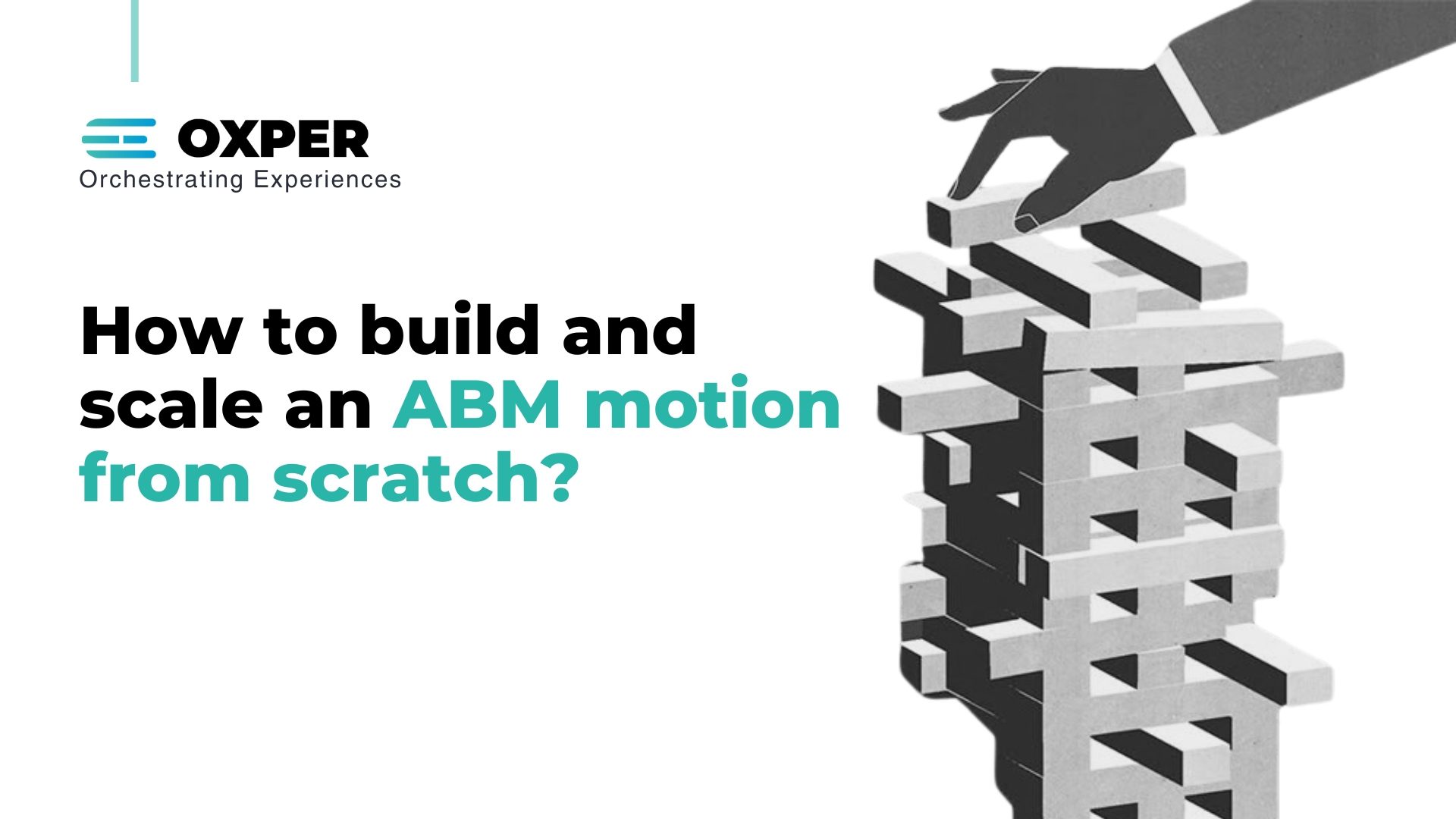What is an ABM Process?
ABM is in the market, and companies of all sizes must begin developing and implementing ABM strategies immediately to avoid losing customers to more savvy rivals. Account based marketing automation (ABM) is a technique in which a provider focuses its marketing and sales efforts on a small number of clients with disproportionately high potential for expansion or growth. Today, we will discuss the essential steps to create and implement an ABM strategy and how Oxper can help you achieve your desired goals.
Key Steps to Implementing Account-Based Marketing
1. How to Choose Your Target Accounts
A thorough and trustworthy understanding of the accounts and target audiences is essential to an account-based marketing approach. To target and nurture accounts through tailored interaction and support, ABM requires marketing and sales teams to make strategic account selections. First, marketing teams should create target company personas based on the high-value clients most likely to convert or expand to formalize the account selection procedure.
Next, analyze what common business goals and values these target customers have and the key steps leading up to a purchase. The more accurate your marketing team can pinpoint high-quality target accounts, the more robust your target company personas should be. CRM software and direct consumer surveys from existing customers can be used to gather this data.
2. Work together with your marketing and sales teams
The next stage is creating robust, data-backed target company personas before designing a pipeline strategy. A strategy for account-based marketing looks considerably different from a strategy for conventional lead generation. Traditionally, marketing-led outreach ends when sales accept a lead from the marketing team, and the sales team handles client contact. Successful account engagement for ABM initiatives necessitates proactive, ongoing cooperation between the marketing and sales teams.
Creating an innovative, targeted campaign across several channels requires collaboration between marketers and sales representatives from the first engagement. This collaborative effort should be continued throughout the sales process, with a strategic marketing presence in digital channels continuing after the typical sales team handoff. As your target buyers continue gathering information and looking for buying assistance, this extended communication gives your marketing team more chances to provide customized content.
The marketing and sales teams should assess the effectiveness of the various marketing and communication channels to determine which ones are most suitable for recurrent tailored outreach, communication, and retargeting efforts. Marketing leaders should develop a list of planned and implemented engagement and nurturing techniques over time in partnership with the sales team and use the checklist to modify their continuing ABM strategy’s outreach and engagement activities.
3. Boost your IT infrastructure and use external targeting tools
The correct software stack and technological expenditures are essential for account-based marketing to succeed. From account selection to engagement and nurturing, ABM software is built to strengthen every critical step of an ABM strategy. It also has reporting and analytic capabilities to help the strategy develop and mature by informing any necessary adjustments.
There are two approaches to provide the resources marketing and sales teams require to implement an effective ABM programme: Adopt an ABM platform that covers every aspect of the process end to end, or start an ABM programme with your current martech stack and scale it with additional tools as needed. Teams seeking solutions specializing in features like improving audience management, proprietary intent data, or even complex reporting and data modeling can locate solutions that handle some aspects of the ABM process and enhance their existing marketing technology.
For instance, intent data can add a wealth of exclusive, third-party user data to existing customer data. By including this particular technology in current sales and marketing tech stacks, teams are given the ability to build buyer personas using a wealth of demographic and behavioral data.
Common ABM Challenges & How to Overcome Them
Although ABM holds incredible potential, there is certainly a level of complexity that partners must work through–engaging and aligning sales and marketing teams, considering the appropriate technology within the existing tech stack, developing personalized content at scale, and a myriad of other aspects.
Furthermore, many organizations struggle with determining appropriate target accounts or shifting their approach based upon what real-time data is suggesting. Addressing these problems requires cross-functional collaboration and communication, the right tech stack, as well a frequent, concerted engagement to engage in testing, iterating, and optimizing. Organizations that invest in training and shifting processes will be able to work through ABM’s obstacles and get to the full, profitable potential of ABM.
Conclusion
Account-based marketing (ABM) enables companies to engage customers of value in a strategic manner by employing precise targeting, coordinated sales-marketing campaigns, and strong tech enablement. ABM can change the way companies drive growth, from selecting the right accounts and developing targeted personas to aligning teams and executing data-driven outreach.
Want to start your own ABM strategy? Talk to us about how Oxper can help you build, execute and scale a results-based ABM program that aligns with your goals.
FAQs
1. What is account-based marketing (ABM), and how does it work?
Account-based marketing (ABM) is a highly targeted B2B marketing approach where sales and marketing teams work together to identify high-value accounts and create personalized campaigns designed specifically for those accounts. Instead of casting a wide net, ABM account based marketing focuses on a smaller set of strategic prospects, tailoring content and engagement to each account’s needs. This increases the chances of conversion and long-term client relationships. Through account based marketing automation, businesses can streamline and scale personalized outreach using data and tools to track engagement and optimize campaigns over time.
2. How is ABM different from traditional marketing strategies?
Traditional marketing strategies focus on reaching a broad audience to generate leads, often relying on volume and funnel-based models. In contrast, account-based marketing flips the funnel—starting with identifying target accounts and then delivering personalized content to decision-makers within those companies. While traditional marketing casts a wide net, ABM account based marketing is laser-focused, enabling higher ROI, better alignment between marketing and sales, and deeper customer relationships. The account based marketing process ensures that every touchpoint is strategic, relevant, and aimed at progressing specific high-value accounts.
3. What are the key steps in the account-based marketing process?
The account based marketing process involves several strategic steps:
- Identify and select target accounts based on revenue potential and strategic fit.
- Align sales and marketing teams to collaborate on goals, messaging, and outreach strategies.
- Develop personalized content and campaigns for each account.
- Engage across multiple channels—email, social media, events, and more—using tailored messaging.
- Measure and optimize with analytics and account based marketing automation tools to refine your approach.
Each step in account-based marketing is designed to deepen relationships with key stakeholders and move them closer to a buying decision.
4. How can businesses identify and select the right target accounts for ABM?
Selecting the right accounts is a critical part of the ABM account based marketing strategy. Start by analyzing your current high-value customers to identify common traits such as industry, company size, revenue, and behavior. Use CRM data, firmographic insights, and intent data to build an ideal customer profile (ICP). Businesses can then prioritize accounts based on strategic fit and growth potential. Leveraging account based marketing automation tools helps streamline this selection process and ensures marketing efforts are focused on accounts with the highest ROI potential.
5. Why is collaboration between sales and marketing teams important in ABM?
In account-based marketing, success hinges on close collaboration between marketing and sales teams. Unlike traditional marketing where teams often work in silos, the account based marketing process requires both departments to share insights, align messaging, and jointly nurture target accounts. This alignment ensures consistent communication, maximizes engagement across the buyer journey, and shortens the sales cycle. Through synchronized efforts and shared KPIs, account based marketing automation can also be better utilized, ensuring that every touchpoint is meaningful and contributes to the overall account strategy.





